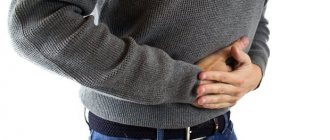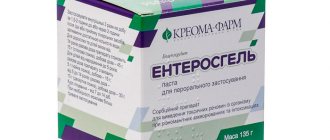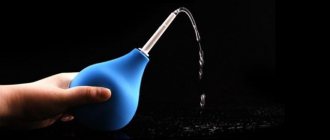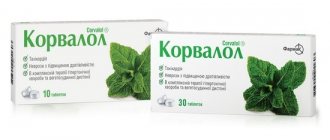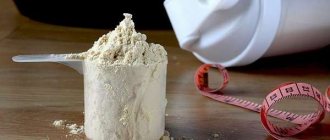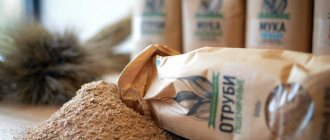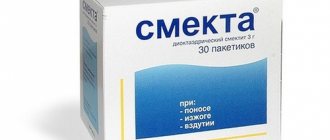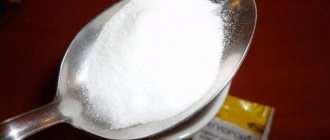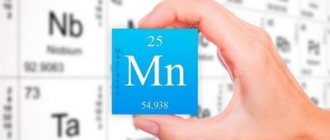Lactofiltrum is an enterosorbent of plant origin.
It restores the normal composition of intestinal microflora and cleanses the body of toxins. Lactofiltrum is prescribed for poisoning, dysbiosis, allergic dermatitis, after courses of antibiotics. The drug also stimulates intestinal immunity. The product contains 2 substances: natural enterosorbent lignin (polyphan) and lactulose (prebiotic). Lignin is produced by hydrolysis of some of the constituents of wood. It binds toxic substances, allergens, alcohol, pathogenic microorganisms, drugs. It also binds excess amounts of products formed during the metabolism of the human body, which can cause poisoning (for example, bilirubin and urea). Like all enterosorbents, lignin is safe for the body, is not absorbed into the bloodstream, and is excreted from the large intestine within 24 hours.
Lactulose acts only in the large intestine. It is not absorbed in the stomach and small intestine. It promotes the growth of beneficial lactobacilli and bifidobacteria. Also, by forming beneficial acids, this prebiotic inhibits harmful microbes and their release of toxins. As a result, intestinal function improves and stool normalizes.
Types and list of antiemetic drugs
Two areas in the brain are responsible for the occurrence of vomiting. The first is the vomiting center, which is activated by impulses coming from peripheral nerve cells. The second is the chemoreceptor trigger zone. It reacts to changes in blood composition, then sends signals to the vomiting center. Antiemetics suppress the activity of the receptors in this area and block the functioning of the vomiting center.
Serotonin receptor antagonists
Serotonin is one of the biologically active substances responsible for the transmission of electrochemical nerve impulses. Plays the role of a cellular mediator of inflammation. An increase in its concentration leads to vomiting. This group of drugs blocks serotonin receptors. Because of this, the release of serotonin is not suppressed, but the reaction in the form of vomiting does not occur. The main “point of application” is the 5-HT3 receptors located in the gastrointestinal tract and chemoreceptor trigger zone. Representatives:
- Ondansetron. Available under several trade names: Emetron, Zofran, Latran. Does not have a sedative (calming) effect and does not impair coordination of movements. It is actively metabolized in the liver, and therefore requires dose adjustment in case of liver diseases.
- Granisetron. Trade names: Kitril, Avomite. It lasts longer than ondansetron, but is also broken down in the liver.
- Tropisetron. He is Navobane, Tropindol. In terms of effectiveness and duration of action, it is comparable to granisetron.
Histamine H1 receptor blockers
Histamine is a mediator of inflammation. Antihistamines are mostly known as anti-allergy medications, but can also suppress vomiting. They block H1 receptors of the chemoreceptor trigger zone and the vestibular analyzer, responsible for assessing the position of the body in space. Only 1st generation antihistamines are suitable as antiemetics because they penetrate the central nervous system. Representatives:
- Promethazine. Better known as Pipolfen. Additionally prevents and eliminates hiccups. The action lasts for 6 hours, sometimes 12 hours.
- Meclozine. Trade name: Bonin. Effective 1 hour after administration. Duration of effect – 24 hours.
- Diphenhydramine. Diphenhydramine. It is used not only as an antiemetic, but also as a hypnotic.
Anticholinergic
The main task of these drugs for vomiting is to prevent or suppress the interaction of acetylcholine (a neurotransmitter) and M-receptors in the chemoreceptor trigger zone. Anticholinergics have not only antiemetic, but also antispasmodic and sedative effects. Examples of drugs:
- Atropine. One option is Atropine Nova. Found application in ophthalmology, treatment of gastroenterological diseases.
- Scopolamine. Preparations based on this substance are used in the treatment of parkinsonism.
- Metacin. It is often used as an antispasmodic for gastrointestinal diseases. Suppresses excess secretion of the bronchial and salivary glands.
Dopamine antagonists
Dopamine is a neurotransmitter that causes vomiting when trigger zone chemoreceptors are stimulated. Due to the activation of peripheral receptors, it increases the reflux of the food bolus (reverse reflux) from the duodenum into the stomach and from the stomach into the esophagus. There are several subgroups of drugs that block dopamine receptors. Representatives:
- Metoclopramide. One of the names under which it is sold is Cerucal. Additionally blocks 5-HT4 serotonin receptors. Refers to benzamides.
- Domperidone. Better known as Motilium. Mainly acts on peripheral dopamine receptors in the gastrointestinal tract. Its chemical properties are similar to Metoclopramide.
- Chlorpromazine. Found its main use in psychiatry, but can be used for severe nausea and persistent hiccups. Refers to phenothiazines.
- Droperidol. Blocker of central dopamine receptors. Used in preoperative preparation before anesthesia. Part of the butyrophenone group.
There are drugs that immediately block histamine, dopamine, and cholinergic receptors. One of these is Amitriptyline. It is most often used as an antidepressant.
Action of the medicine
Laktofiltrum belongs to the enterosorbents. The effect of the drug is explained by its medicinal components.
Lignin is a natural enterosorbent. It consists of hydrolysis products of wood substances. Lignin, entering the intestine, adsorbs on its surface microorganisms, medications, heavy metal salts, ethyl alcohol, allergens, metabolic end products such as bilirubin, cholesterol, urea, biogenic amines and other compounds that can cause poisoning.
Lignin does not have a harmful effect, since it is not adsorbed and is completely evacuated from the body within 24 hours.
Lactulose is an artificial disaccharide that consists of galactose and fruit sugar molecules. It is released from the tablets in the colon. Here, lactulose is fermented by normal intestinal flora, substances are formed that serve as a nutrient medium for the growth of bifidobacteria and lactobacilli. Also, in the process of chemical reactions, lactate, ethanoic and methanoic acids are synthesized from the disaccharide, which stop the proliferation of pathogenic bacteria and reduce the formation of dangerous nitrogen-containing compounds. In addition, osmotic pressure in the colon increases, which stimulates intestinal motor function.
The action of the medication is aimed at normalizing the intestinal microflora and reducing the severity of poisoning by toxic compounds that form in the body.
Lactofiltrum for vaginal dysbiosis enhances the effects of other medications that are used to treat this disease, and it also suppresses the proliferation of opportunistic bacteria and fungi, and increases the number of lactobacilli.
Features of the use of antiemetic drugs
Antiemetics are selected according to the cause of vomiting. There is no universal drug. Antiemetics can suppress discomfort, but do not affect the actual cause of vomiting. You can take them only after consulting a doctor.
For rotavirus in children
Dopamine receptor blockers are used. Domperidone (Motilium) is approved for infants. It normalizes gastrointestinal motility and eliminates vomiting.
During chemotherapy
The effect of chemotherapy drugs is accompanied by a powerful release of serotonin. Therefore, preference is given to serotonin receptor antagonists: Ondansetron, Tropisetron, Granisetron. Their effect, if necessary, is enhanced by combining with dexamethasone.
The second line drug is Metoclopramide. In high doses, it is able to block not only dopamine receptors, 5-HT4, but 5-HT3 receptors, which play a major role in the genesis of vomiting during chemotherapy.
In case of poisoning
Just like with rotavirus, dopamine receptor blockers are indicated. Metoclopramide and Domperidone have proven themselves well.
During pregnancy
Pyridoxine (vitamin B6) and mint tablets are considered safe. They are used for mild nausea. If these drugs do not help, resort to the use of stronger antiemetics.
Dopamine receptor blockers are used with caution. Metoclopramide is allowed in the early stages. It cannot be used in the third trimester of pregnancy.
Second-line drugs are antihistamines. Pregnant women can be prescribed Bonin (Meclozine).
In case of intoxication
For intoxication with alcohol and cardiac glycosides, dopamine receptor blockers are used: Metoclopramide, Domperidone.
For intoxication with synthetic drugs, dopamine receptor blockers (phenothiazines and butyrophenones) are also used: Chlorpromazine, Haloperidol.
With vomiting of vestibular origin
To stop vomiting during motion sickness, antihistamines are used. Meclozine (Bonin) is used.
M-anticholinergics are effective. The drug of choice is Aeron (based on scopolamine).
Dopamine receptor blockers (Metoclopramide) are ineffective for vestibular vomiting.
Indications for use of Lactofiltrum for children
The instructions for the drug Lactofiltrum for children state that it can be used if the following pathologies are observed:
- intestinal dysbiosis of various origins, including those arising from taking antibiotics,
- allergy, which manifests itself as urticaria, atopic dermatitis.
In combination with other drugs, Lactofiltrum is recommended for children with irritable bowel syndrome, inflammation and cirrhosis of the liver.
In addition, adults and children can drink Lactofiltrum if they have vaginal dysbiosis.
Contraindications
A general contraindication for all antiemetic drugs is hypersensitivity to any of its components. 5-HT3 receptor blockers should not be prescribed to pregnant women, breastfeeding women and children under 2 years of age.
The exact restrictions on medications depend on the type of medication. For this reason, you should always read the annotation for each of them.
For histamine receptor blockers
| Absolute | Relative |
|
|
For anticholinergics
| Absolute | Relative |
|
|
For dopamine antagonists
| Absolute | Relative |
|
|
Why do you feel sick and vomit?
- Immune reactions - during pregnancy lead to nausea in the 1st trimester
- Irritation of the vagus nerve - bacteria, viruses, protein breakdown products during tumor processes and inflammation of the gastrointestinal tract causes nausea
- Nausea of central origin - associated with irritation of the vomiting center in the brain, occurs: with an increase in blood pressure against the background of hypertension or vegetative-vascular crises
- with intracranial hypertension or meningeal irritation
- for diseases of the inner ear
- with irritation of the semicircular tubules due to motion sickness
The causes of vomiting can be divided as follows:
- Infections: viral (hepatitis, entroviruses), bacterial (toxins of staphylococci, Salmorella, Escherichia coli, Bacillus cereus, Vibrio cholerae, Clostridia, Yersinia).
- Toxic influences: poisons or alcohol, medications (drugs, cytostatics, aminophylline, cardiac glycosides).
- Severe abdominal pain (peritoneal inflammation, pancreatitis, cholecystitis, acute myocardial infarction).
- Narrowing or obstruction of the gastric outlet (cicatricial stenosis, tumors).
- Intestinal obstruction (intussusception, Crohn's disease, tumor, foreign body).
- Central vomiting (increased intracranial pressure, neuroinfection, lesions of the vestibular apparatus in Meniere's disease or its irritation during motion sickness).
- Metabolic and endocrine causes (hyperthyroidism, Addison's disease)
- Pregnancy
- Radiation sickness
Are there any side effects?
| Type of antiemetic | Side effects |
| Serotonin receptor blockers |
|
| Anticholinergic and antihistamine drugs of the 1st generation |
|
| Dopamine antagonists |
The last three side effects concern butyrophenones and phenothiazines. |
prokishechnik.info
Vomiting is a protective reaction of the body, an unconditioned reflex. It often occurs in childhood. Parents of infants most often experience regurgitation. It usually does not require special treatment, but in some cases it will require consultation with a specialist.
Vomiting can be single or multiple. It can be a symptom of food poisoning, as well as other disorders. This condition requires mandatory treatment. The child should be shown to a doctor, who, if necessary, will recommend antiemetic drugs for children. If the baby is truly poisoned, then such medications are used only after the baby’s stomach has been cleansed. The doctor will also give recommendations on how to prevent dehydration, which can very quickly occur in a child in such a situation.
Antiemetics for children
One of the drugs that is prescribed to children with a similar problem is Motilium.
It is available in different forms, for example, tablets, suspensions. The active component of the drug is domperidone. In rare cases, Motilium can cause disturbances in the functioning of the nervous system in children. But they are reversible and go away after stopping the medication. Also in some cases, a rash and intestinal disorders appear.
For children, antiemetic tablets or Cerucal injections may be prescribed .
The injection solution can be administered to pediatric patients from 2 years of age. Tablets are prescribed at older ages (after 14 years). Cerucal should not be used by those diagnosed with epilepsy. Also a contraindication to its use is age under 2 years and intestinal obstruction.
No-Spasm
- another tool that will help cope with the problem. It is important that this antiemetic can be used for children under one year of age. The medicine is available in the form of tablets, syrup and injections. They can be administered in different ways. Adverse reactions to the drug include constipation and increased intraocular pressure. If the medicine is administered intravenously, it should be done slowly. If the manipulation is carried out quickly, then there is a high risk of a sharp decrease in blood pressure.
There are also anti-nausea suppositories for children. For example, Domperidone
may be assigned in this form. It helps cope with nausea and vomiting, as well as other digestive tract disorders. It can be used even by the smallest, but the specifics of the treatment must be determined by the doctor. He will recommend the optimal dosage and course duration.
In addition to antiemetic drugs for children, the doctor recommends a set of measures to prevent dehydration:
- Regidron can be prescribed, it is able to restore water balance well;
- effectively give an absorbent drug, for example, Enterosgel;
- You can also restore your water balance by drinking plenty of fluids;
- Sometimes it is recommended to drink a decoction of raisins.
Drinks should be taken in small sips, little by little and often. If the baby asks to eat, then you need to give him food in small portions.
Food should be dietary and light.
Parents should remember that vomiting is not always a sign of poisoning. Sometimes it can be a manifestation of a concussion, which is most often treated in a hospital setting. A correct diagnosis is one of the conditions for recovery. This is why it is so important to immediately show the child to the doctor. After all, his task is not just to prescribe antiemetic medicine for children, but, first of all, to find out the causes of this condition.
Self-medication can not only be absolutely useless, but also cause serious harm to the health and well-being of the child.
womanadvice.ru
Reviews
The reviews are positive. Eg:
Daria, housewife. The drug is wonderful. The composition and properties are suitable for almost everyone, regardless of whether it is a child or an adult. There is always this medicine at home. For eating disorders it is our best assistant.
Andrey, therapist. A good drug, it helps every time you have digestive problems. The doctor himself. I take the drug and advise it to patients.
German, student. Lactofiltrum is one of the best remedies. My father drinks often. To help him cope with his hangover, I give him this medicine. Works flawlessly.
Acute and chronic poisonings are not uncommon these days. Many products and medicines are of poor quality. And as a result, food or drug poisoning occurs. One of the latest effective drugs is Lactofiltrum for poisoning. It has a positive effect on the condition of the intestines, restores and normalizes microflora, and also improves intestinal motility.
First aid
If a child begins to vomit repeatedly, then it should be considered as a symptom accompanying poisoning. In this case, mothers need to perform gastric lavage using salted water for this purpose. Children should be allowed to drink as much liquid as they can, after which gentle pressure should be applied to the root of the tongue with your fingers. Such actions will provoke a gag reflex, and all the contents of the stomach will come out. The procedure must be carried out until clear water begins to come out. Only after this can a child's antiemetic be given.
It is worth noting that children can only rinse their stomachs on their own from the age of three. For children under this age, all manipulations should be performed in a hospital setting, under the supervision of specialists.
Antiemetics: a panacea for vomiting?
Antiemetic drugs for children are prescribed only by general practitioners. Parents should not choose antiemetics on their own, even if they are suitable for the child’s age. Anti-vomiting drugs have several important nuances that parents need to know about:
An antiemetic mixture is prescribed by a specialist after the child has been examined and the diagnosis and cause of vomiting have been determined . Antiemetics are used when profuse vomiting is diagnosed with:
p, blockquote 24,0,0,0,0 —>
- Skull injuries.
- Gastrointestinal pathologies.
- Disturbances in the functioning of the central nervous system.
All of the above conditions threaten the child’s life, and therefore require the use of more than just antiemetics.
How to replenish lost fluid
If the baby vomits after eating, then in this case the reflex can be considered as a normal physiological phenomenon. But when a child experiences repeated vomiting, parents need to immediately begin taking actions aimed at replenishing lost fluid. In between urges, you need to give the baby special solutions to drink in order to prevent dehydration, which can be fatal for a fragile body.
To replenish the water-salt balance, the following means should be used:
- Still water.
- Decoctions personally prepared from dried apricots and raisins.
- Pure water, to which a small amount of natural honey and a few drops of lemon juice have been added.
- The ideal solution would be to use special medications that are sold in powder form in pharmacies. For example, "Regidron". But it doesn’t have a very pleasant taste, so kids don’t drink it very willingly.
- It is forbidden to give children dairy products, carbonated water, or strong teas at such moments.
What to drink for nausea at home: folk remedies
You can drink herbal tea for nausea at home.
You can drink herbal tea for nausea at home:
- Mint tea. To prepare this product, you can take both dry and fresh raw materials. So, take 1 tbsp of chopped mint and pour 250 ml of boiling water over it. Let the tea brew, strain, add a teaspoon of honey and drink warm in small sips. If nausea haunts you around the clock, drink this tea 3-4 times a day.
- Chicory infusion. Take 2 tablespoons of chicory, pour it into a thermos and pour 1 liter of boiling water. Leave the product for 1.5-2 hours and you can use it. If desired, you can sweeten it with a little honey. Use no more than 150 ml of chicory infusion at one time.
- Citrus peels. This raw material can be used in several ways. If you wish, you can dry the peels, grind them, and then prepare a kind of tea from them and drink them when nausea occurs. If you want to get the most effective remedy, you can grind dry citrus peels, add crushed mint to the resulting mass, and brew tea from this mixture.
Antiemetic tablets for rotavirus and poisoning
Anti-vomiting medications should only be given after consultation with pediatricians if children have been diagnosed with rotavirus or food poisoning. In such situations, specialists may prescribe the following medications:
If a child is suspected of having rotavirus, then parents should not immediately give him medications that stop the gag reflex. This is due to the fact that when eliminating vomiting with medications, the child’s body will not have time to cleanse itself of pathogenic microflora in a natural way. As a result, the pathology can drag on and provoke serious complications.
Effect of Lactofiltrum on the intestines
When poisoned, the body is subject to severe stress and exhaustion. As a result, the body becomes exhausted and immunity decreases. If the symptoms of poisoning disappear within a few days, the drug should be taken for a few more days. Lactofiltrum strengthens and supports the body, as well as:
- increases intestinal immunity;
- restores intestinal microflora;
- eliminates the effects of toxins;
- absorbs cholesterol molecules, reducing its level in the blood;
- eliminates diarrhea;
- improves intestinal function;
Cleansing the body with Lactofiltrum can be carried out without poisoning. The drug has an antioxidant effect.
Review of the most popular drugs
When eliminating vomiting in children, you can use only safe medications that have a minimal list of contraindications and side effects.
"Cerucal"
The manufacturer of the drug uses Metoclopromide Hydrochloride as the active substance. The medicine is supplied to pharmacy chains in tablet form, as well as in the form of an injection solution. Pediatricians prescribe this drug for severe vomiting, which is followed by repeated vomiting. It can be given to children who are already two years old. The daily dosage is calculated depending on the patient's weight. For children whose age varies in the range of 2-14 years, the dose is determined in this way: 0.5 mg per 1 kg of weight. The medicine should be taken 30 minutes before meals. The pharmacological effect will begin 15-20 minutes after administration and will be observed for six hours.
The manufacturer of the drug notes the following as contraindications:
- Development of glaucoma.
- The presence of individual intolerance to the components of the drug or lactose.
- Development of intestinal obstruction.
- Epileptic seizures.
- Presence of hypotension.
- Suspicion of internal bleeding.
As for side effects, the manufacturer warns about the possible development:
- drowsiness fatigue;
- dizziness;
- persistent migraine;
- allergic reactions;
- nervous tic;
- irritability;
- fears and anxiety;
- diarrhea.
"Motilium"
The drug is supplied to pharmacy chains in the form of a suspension and in tablet form. It is indicated for use in cases of digestive processes in which stagnation occurs. The medication is also prescribed for infants with systematic regurgitation, and for older children with hiccups, heartburn, vomiting and flatulence. The dosage is calculated based on the weight of the babies: 2.5 ml per 10 kg of body weight. You should take the medicine no more than three times a day, 30 minutes before your main meals.
The manufacturer's instructions for the drug indicate all contraindications:
- parallel use of antibacterial and antifungal medications;
- malignant neoplasms identified in the pituitary gland;
- increased prolactin levels;
- intestinal obstruction;
- suspicion of bleeding in the gastrointestinal tract;
- period of lactation and gestation;
- individual intolerance to the components included in the medicine;
- the drug is not prescribed in tablet form to children whose body weight does not reach 35 kg;
- The medicine is given to babies under one year old only in the form of a suspension and with great caution (the doctor prescribes it only after assessing all the risks and after weighing the baby).
The following side effects may occur while using the medication:
- The processes of defecation are disrupted.
- Drowsiness develops.
- Persistent migraine is observed.
- Severe pain appears in the intestines.
- Nervousness and excitability increase.
- An unquenchable thirst arises.
- Endocrine system disturbances may occur.
- Allergic reactions develop, and in some cases Quincke's edema may occur.
In most cases, side effects resolve on their own when the drug is discontinued. But, if the baby experiences any complications, he should immediately be shown to a pediatrician for prescriptions.
ogastrite.ru
How does Lactofiltrum work?
First of all, it must be said that the drug contains 2 fast-acting and effective substances. The drug is several times more effective than regular activated carbon. Lactofiltrum is not taken as activated carbon, 1 tablet per 1 kg. Fewer tablets are needed per dose. As a rule, the body can easily tolerate the effects of Lactofiltrum in case of poisoning and can be treated.
Lactofiltrum contains lignin and lactulose. Lactulose in normal microflora is synthesized in the intestines. Thanks to it, lacto- and bifidobacteria are formed. Lactofiltrum contains synthetic lactulose, which forms organic acids that can eliminate harmful bacteria and their metabolic products, including substances containing nitrogen. As a result, pressure on the intestinal walls increases and digestion improves.
Lignin is a product that is produced from plant cells whose walls have become woody. It is an enterosorbent with a high degree of absorbency. Once in the intestines, it binds molecules of heavy metals, toxins, waste products of microorganisms, etc.
Taking Lactofiltrum in case of poisoning has the following effect:
- antimicrobial;
- antidiarrheal;
- sorbent;
- antiemetic;
How to help your child
If the baby vomits, there is no fever or pain, the baby feels healthy and is already 1 year old, most likely this is the body’s response to an external irritant or overwork. It is acceptable to observe the baby for a while before calling a doctor.
In all other cases, a qualified specialist is required.
Timely assistance will prevent possible complications:
- Calm the baby and pull yourself together. Don't leave him alone. Provide bed rest, lying on the side on high pillows. Newborns should be held upright or horizontally on their side in the arms of an adult.
- When vomiting, the baby should be seated with his body bent forward. Rinse your mouth after gag reflex with boiled water. Wash the skin on which the vomit has come into contact.
- Drink 1 teaspoon every 5-10 minutes; for children over 2 years old, 1 tablespoon of warm water, rigedron, rice broth, chamomile solution.
- Don't feed. You should not eat food earlier than 5 hours after an attack and without the consent of the baby. An exception is for breastfed children; they must be put to the breast on demand.
- Using medications without a doctor's prescription can only cause harm. The exceptions are antipyretics and sorbents for children (activated carbon, smecta).
Activated carbon (black tablets) for vomiting in children quickly absorbs toxins, is safe, and is dosed depending on weight.
Smecta (white powder) – absorbs toxic substances, has enveloping effects that protect against irritation, and is harmless to children.
What antiemetics are best for a child?
In the table we present drugs that help cope with the signs of vomiting and nausea.
p, blockquote 26,0,0,1,0 —>
| Medicine | Release form | Age category | Medicinal effect | Analogue drugs |
| "Motilium" |
| From birth and older | Normalizes intestinal motor function. Eliminates symptoms of heartburn, colic, bloating. | “Domstal”, “Damelium”, “Motilak”, “Domperidone”. |
| "Atropine" |
| Infants, children one year and older | “Closes” the vomiting center. Reduces the tone of the gastrointestinal tract. Reduces the secretory abilities of the digestive organs. | "Atropine sulfate" |
| "Cerucal" |
| From 2 years and more | Responsible for blocking the vomiting center. With its help, intestinal motility is enhanced. Gastric contents enter the small intestine more quickly. | "Perinorm" |
"Metoclopramide."
Causes of vomiting
Before the doctor arrives, parents need to make every effort to identify the characteristic symptoms accompanying nausea and vomiting, which will help with treatment and establishing the correct diagnosis.
Vomiting often appears in a child against the background of elevated body temperature, diarrhea, abdominal pain; symptoms may be absent.
There can be many causes of the disease, let’s consider the main ones:
- In infants - immaturity of the digestive system, excess swallowed air during feeding or crying, forced feeding, elevated body temperature, developmental abnormalities.
- Food – poor quality, poorly washed food, too fatty food, eating it in excess, overeating, food intolerance, water from open sources.
- Drug intoxication.
- External factors - motion sickness in transport, climate change, sunstroke, overheating, stress, lack of oxygen (stuffy room, low humidity).
- Diseases - poisoning, rotavirus, intestinal infections, pathologies of the gastrointestinal tract, nervous, endocrine system, traumatic brain injury, intracranial pressure, meningitis, tumors, ARVI, metabolic disorders, appendicitis, allergies, kidney, heart failure and others.
Release form and composition
"Lactofiltrum" is available in only one dosage form, which is tablets. They have a capsule shape, convex on both sides, and there is a line along which the tablet can be divided into halves. The color of this medicine is dark brown, but the structure of the tablets contains inclusions of white-gray color. The medication is placed in contour packages of 10–15 pieces or in plastic jars and is sold in 30 or 60 tablets in one box.
The effect of the drug is due to the combination of two active ingredients at once. One of them is hydrolytic lignin, which is extracted from wood. Its dose, if we recalculate the amount of dry matter, is 355 mg in each tablet. The second active ingredient of Lactofiltrum is a synthetic disaccharide called lactulose. The amount of this ingredient per tablet is 120 mg.
Among the inactive components of the drug are microcrystalline cellulose and croscarmellose sodium, as well as magnesium stearate. Such substances are added to the drug to obtain a dense tablet and give it the desired shape.
Treatment with medications
Medication treatment is prescribed only by a doctor. It is unacceptable to prescribe medicine for a child on your own and take it before the pediatrician arrives.
This will blur the entire clinical picture and complicate the work in making a diagnosis, as a result of which time may be lost and the baby will have to be hospitalized.
As a rule, the treatment regimen for vomiting in a child is as follows:
- absorbents and adsorbents are prescribed that absorb toxins and remove them from the baby’s body;
- for abdominal pain in children, antispasmodics are used;
- if the baby has an elevated temperature, use antipyretics;
- if necessary, children are prescribed antiviral, antimicrobial drugs, antibiotics;
- for concussion - anticonvulsants.
If a child is vomiting and has a fever, but is more worried about the pain that appears first, then urgent hospitalization is necessary, perhaps this is a surgical case (appendicitis, inguinal hernia, etc.).
If the baby is under one year old, medications are used in a form convenient for them - syrup, suspension, suppositories. For convulsions, loss of consciousness, vomiting and in severe cases of dehydration, intravenous infusions are administered.
Antiemetics for children
Before using antiemetic drugs on young children, mothers should consult with pediatricians. Experts for this category of patients recommend using the following medications:
This antiemetic for a child has an effect on cholinergic receptors. It is prescribed to children in the presence of functional spasms, with the development of gastroenteritis, as well as in case of individual intolerance to drugs. When determining the daily dosage, pediatricians must take into account the patient’s weight. The dose of medication per day is 1 mg: 1 kg of body weight. As side effects, the manufacturer of the drug indicates that the pupils may dilate and drowsiness may appear. Antiemetics are not prescribed for children if they have pathologies of the urinary system
Motilium suspension and tablets
The active substance in the medicine is Domperidone. Experts recommend using Motilium suppositories for children against vomiting, as well as a suspension
Enterofuril capsules and suspension
This medicine has an antimicrobial effect. It contains Nifuroxazide as an active component. The medication can be given in the form of a suspension to infants from one month and to children up to 7 years old. Pediatricians do not recommend using it simultaneously with adsorbents. As a side effect, the manufacturer indicates the possibility of developing intestinal dysbiosis. That is why, after eliminating vomiting with this medicine, children should take a course of probiotics
Medicines to help stop vomiting
You need to know that the remedies used for vomiting for children only eliminate an unpleasant symptom and do not treat the root cause. Therapy is carried out for children using 2 methods - eliminating symptoms and treating the underlying disease.
Anti-vomiting medications for children tend to differ from those prescribed for adults due to the difference in dosage. Most often, children's products are produced as sweet syrups and suspensions.
Cerucal
The active substance metoclopromide acts quickly on the vomiting center and inhibits the process, while at the same time speeding up the work of the stomach and intestines for emptying. The medicine is intended for children from 3 years of age, sometimes it can be prescribed at the age of 2 years.
Available in the form of tablets, ampoules for oral or intramuscular administration. The daily dose is calculated based on the child’s weight and divided into 3 doses. Take the product 30 minutes before meals.
Modern analogues of the drug are Metoclopramide, Perinorm, Reglan.
Motilium
Prescribed for nausea and vomiting, bloating, belching, heartburn. The drug can be taken from one month. Produced in tablets, for children under three years of age in the form of a suspension. The active ingredient is domperidone.
It is advisable to drink before meals 3-4 times a day, dosage based on body weight. After eating, absorption of the drug decreases. When using other medications, observe a half-hour interval.
It has substitutes - Motilak, Motizhekt, Domstal, Domperidone, Damelium.
No-Spasm
Antiemetic, relieves abdominal pain, reduces gastric secretion, a remedy for children. The release form of the product is tablets, syrup, solution for invasions. The drug is approved for infants. Take with meals 3 times a day, according to the prescribed dosage.
Do not use this product together with medications containing paracetamol.
Diakarb
Prescribed to children aged 3 years, when vomiting, reduces intracranial pressure. Available in tablet form. The dosage and number of medications taken by children is determined depending on the diagnosis.
You can replace the medicine with Acetazolamide.
Riabal
Riabal helps the child against vomiting, relieves pain from spasms of the gastrointestinal tract, reducing the secretion of digestive juices.
It exists in the form of tablets, syrup, and injections. Take the medicine in three doses per day, 1-2 weeks. Children under 6 years old every 6-8 hours according to the prescribed dosage.
Attention! A severe allergic reaction to the drug substance is possible.
Bromopride
A drug for nausea and vomiting, improves motility of the gastrointestinal tract, removes hiccups. Available in the form of capsules, suppositories in several dosages, solution in ampoules. The anti-vomiting medicine is given to the child 1-2 times a day on an empty stomach. The active substance of the drug is bromopride.
Atropine
Anti-vomiting medicine for infants and older. The drug is available by injection and eye drops. The dosage of the medicine for children is determined strictly by a competent specialist.
Analogues: Atropine sulfate.
Characteristics of Lactofiltrum
Lactofiltrum is packaged in a box that attracts attention with a bright color inscription. The medicine is tablets containing a sorbent. An analogue of the drug - Lactofiltrum ECO, differs in the form of release. Along with the tablets, lozenges and powder are produced. Reviews for any type are positive – for the most part.
The manufacturer of the drug declares the equality of both products. But Lactofiltrum is a medicinal medicine, Lactofiltrum ECO is a dietary supplement, containing a dye and flavoring.
Both types are equally effective for mild poisoning. The only difference is the dosage, depending on the form of release.
The components of the drug are two types of substances:
- Lignin. Made from cellulose. The method of obtaining the component is the processing of trees. The component has a fiber structure. When applied, the mucous membrane is coated. The task of the component is to absorb poison.
- Lactulose. A synthetic substance created artificially. Thanks to the effect, the intestines are provided with favorable microflora that promote contraction processes.
Precautionary measures
Uncontrolled use of anti-vomiting drugs leads to deterioration of the condition and side effects, such as drowsiness, dizziness, disturbances in heartbeat, breathing, intestinal dysfunction, etc.
In case of poisoning, intestinal infection and rotavirus, the use of anti-vomiting drugs is unjustified, since vomiting in these cases rids the child’s body of toxins.
If a child’s vomiting is associated with injuries, neurological disorders, gastrointestinal pathologies, or is life-threatening, then children should be given an antiemetic.
Use for alcohol intoxication
Lactofiltrum removes excess alcohol from the stomach, small and large intestines, neutralizes toxins after the breakdown of ethyl alcohol. Additionally, it normalizes stool and helps restore the complex of beneficial intestinal microorganisms.
In case of intoxication due to alcohol abuse, the drug is taken in larger doses than for food poisoning. If you drank too much alcohol during the feast, you can immediately take several tablets and again - a few more before bed. To reduce the symptoms of a hangover in the morning, you need to empty your bowels and take the drug again. When taking drugs for hangover syndrome (for example, Antipohmelin), it is necessary to maintain an interval of 1-1.5 hours.
Diet
A diet that is based on proper nutrition and drinking plenty of fluids will help your baby recover from vomiting. Food should not be heavy and portions should not be small. Liquid and finely ground soups will have a beneficial effect. Food for the baby should be boiled and pureed; fried, sour, salty, baked foods are not allowed.
The following will be effective in the functioning of the stomach: porridge - buckwheat and rice, yogurt without additives, low-fat kefir, boiled broccoli and carrots, boiled chicken breast, veal soufflé, bananas, baked apples, biscuits, white bread crackers, strong sweet tea, compote dried fruits without added sugar. Rice water will help your child with vomiting.
Promotes vomiting in children: fish and meat dishes, fresh vegetables and fruits, fats and sausages, carbonated drinks, dairy products, juices, sweets and baked goods.
Traditional medicine for poisoning for children - dill, mint infusions, baked quince, lemon peels.
What to drink for nausea during pregnancy?
Nausea and pregnancy
Pregnancy is a special condition in which a woman’s body is under great stress. Statistics show that almost all women during pregnancy experience toxicosis, which provokes nausea in the morning.
You can drink for nausea during pregnancy:
- Chamomile tea. Chamomile has a pronounced anti-inflammatory effect. Once in the gastrointestinal tract, it soothes the walls of the stomach, and the expectant mother stops feeling nausea and vomiting.
- Melissa tea. This inconspicuous plant also has a lot of positive qualities. It has anti-inflammatory, antiemetic and antidiarrheal effects. To get rid of unpleasant symptoms, a pregnant woman needs to drink 250 ml of tea every morning.
- Herbal tea with ginger and lemon. If you want to get rid of nausea, you can use herbal tea, to which fresh ginger and a couple of lemon slices have been added. This product can be sweetened with honey to improve taste.
Prevention
Preventing vomiting in children at home involves general hygiene, quality products, and well-cooked food.
To help prevent vomiting in children:
- timely treatment of diseases, which will help prevent complications;
- immunoprophylaxis - vaccination of children, taking vitamins, hardening;
- compliance with the rules of personal hygiene of the baby;
- fresh and high-quality products, well-washed fruits and vegetables;
- keep children away from household chemicals;
- Keep medications out of reach and follow the dosage.
otravlenie103.ru
What to drink for nausea and dizziness?
Dizziness is almost always accompanied by nausea.
As a rule, nausea with dizziness is associated with improper functioning of the vestibular apparatus, as well as pathologies of the cardiovascular system. Therefore, in this case, it is necessary not only to fight nausea, but also to solve the problem that provokes it. Only in this case will you get a long-term therapeutic effect from taking medications.
You can drink nausea for dizziness:
- Carvolment. This product is sold in the form of gel capsules, which do not need to be washed down with water. To alleviate your condition, you will need to put one capsule under your tongue and wait until it dissolves. As soon as the contents of the capsule reach the receptors of the oral cavity, nausea will begin to subside.
- Dramamine. This dosage form can very quickly relieve dizziness and nausea. For a longer therapeutic effect, it is recommended to take the medicine 3 times a day, 50 mg.
- Novo-passit. This drug is suitable for those people whose nausea and dizziness are caused by problems with the vascular and nervous system. The drug will have a noticeable calming effect, thereby reducing the load on the heart and blood vessels. Against this background, other unpleasant symptoms will go away.
What will help fight baby vomiting?
In case of bloody vomiting, you should immediately call an ambulance; you cannot give anything to drink, it is better to give an ice cube, and put a cold heating pad on your stomach.
Vomiting is a sign of various diseases. If nausea recurs repeatedly, it is important to get medical help immediately. Before the pediatrician arrives, the child is provided with proper care:
- lay on your side;
- prepare a basin and a container for spitting.
The baby can be held upright.
Abundant drinking regime
Severe attacks deprive the body of the fluid and important microelements necessary for normal functioning. Dehydration is eliminated with alkaline mineral water and special solutions.
The younger the patient, the more dangerous dehydration is for him. The baby can be given water from a pipette or a teaspoon. An older child must drink a lot in small sips over four hours, calculating the volume drunk in milliliters, multiplying body weight by a factor of 75.
The best means of recovery is a rehydration solution. Dissolves in 1 liter of water, 1 tsp. salt, the same amount of soda, 2 tbsp. Sahara. Which ready-made solutions are suitable for children:
- Hydrolyte;
- Regidron;
- Oralit.
Instead of saline solution, another warm liquid will do:
- sugar-free dried fruit compote;
- chamomile infusion;
- weak tea with rosehip.
The closer the temperature of the tea or decoction is to body temperature, the more effective absorption occurs in the stomach, and the less likely there are new urges.
You definitely need to persuade and force the child to drink a lot of liquid throughout the day.
In infants, heavy attacks cause dehydration, usually after 3 hours; it is extremely important to provide him with plenty of fluids.
Meal break
If an attack begins, you need to temporarily stop eating. Short-term fasting is indicated if the baby has an intestinal infection. By skipping several meals, the child’s body will not suffer. If you feel nauseous, you won't want to eat. After vomiting, it is worth feeding the patient, but adjusting the diet:
- feed more often than usual, but in tiny portions;
- prepare the puree and serve it slightly warmed;
- it is necessary to exclude fresh vegetables and fruits, which are difficult to digest due to their significant fiber content;
- Sweets, foods high in salt, fat, fried foods, foods with fast carbohydrates that provoke fermentation are contraindicated.
As for babies fed with breast milk, feeding should not be stopped.
Cancer patients
Patients with cancer may need tablets for dizziness and nausea. During chemotherapy or radiation therapy, nausea and vomiting are common phenomena that complicate the already difficult condition of patients.
- Metoclopramide (Cerucal) in injections or tablets is a time-tested prokinetic agent.
- Serotonin receptor antagonists block the vomiting center. Ondansetron in suppositories, tablets, injection solution: Zofran, Domegan, Ondantor, Lotran, Granisetron (Avomit, Notirol, Kitril), Tropisetron (Tropindol, Novoban).
- Blockers of central dopamine receptors affect the vomiting centers. Trifluoperazine, Haloperidol.
- Benzodiazepines (Diazepam, Lorazepam), in addition to suppressing vomiting and nausea, reduce feelings of fear and anxiety.
- A selective high-affinity antagonist of neurokinin-1 (NK1) receptors of substance P - aprepitant - Emend (1 cap. 1300-1600 rubles).
- A good anti-vomiting remedy is Buscopan in tablets or suppositories.
- In pediatric oncology, preference is given to selective serotonin receptor blockers (Navoban, Kytril, Zofran).
Tropisetron
Indications: nausea during antitumor therapy, vomiting and nausea in the postoperative period. Contraindications: lactation, pregnancy, hypersensitivity, children under 2 years of age. Dosage: capsules 1 hour before meals, on day 1 the drug is administered intravenously, on days 2-6 orally, the solution can be taken orally, diluted with orange juice. Children 0.2 mg/kg body weight, daily dose not more than 5 mg. Adults 5 mg/day intravenously on day 1, 2-6 orally. Side effects: constipation, abdominal pain, diarrhea, dizziness, allergic reactions. |
Ondansetron
Indications: postoperative nausea, after radiotherapy and chemotherapy. Contraindications: children (for rectal administration), children under 2 years of age (for parenteral and oral administration), pregnancy, lactation. Dosage: for adults, the daily dose is 8-32 mg, the drug can be taken orally (syrup, tablet), rectally (suppositories), intravenously or intramuscularly (ampoules with injection solution). To relieve nausea after surgery or chemotherapy, it is recommended to use the drug by injection. Syrup and tablet for resorption, it is also possible to take during moderate emetogenic radiotherapy or chemotherapy 1-2 hours at a dose of 8 mg before the start of therapy, followed by another 8 mg every 12 hours. For highly emetogenic chemotherapy, the dose is increased to 24 mg while taking dexamethasone orally. For late nausea, which occurs within 24 hours, continue taking 8 mg twice a day for 5 days. It is possible to use suppositories at a dose of 16 mg 2 hours before therapy and then continue with 1 suppository. per day for 5 days. Side effects: dry mouth, abnormal stool, hiccups, arrhythmias, decreased blood pressure, bradycardia, dizziness, convulsions, blurred vision, bronchospasm, urticaria, feeling of heat, flushing of the face. |
Granisetron
Indications: Prevention of vomiting and nausea during radiation and chemotherapy in adults. Contraindications: children under 12 years of age, breastfeeding, with caution in case of partial intestinal obstruction, pregnancy, lactase deficiency. Dosage: 2 times / day orally, 1 mg or 2 mg 1 time / day for no more than a week after therapy. The first dose is taken 1 hour before treatment. Side effects: insomnia, anxiety, drowsiness, headache, dizziness, flatulence, constipation, abdominal pain, heartburn, taste changes, urticaria, itching, bronchospasm, hyperthermia, increase or decrease in A, facial swelling, skin rash, flu-like symptoms, chills , fever. |
Medicines for vomiting in children
Treatment should begin with determining the cause. It is advisable to start taking medications after a pediatrician’s prescription.
Purchasing anti-vomiting medications without the advice of a pediatrician is not always safe and is fraught with complications. Medicines of this type make you sleepy, blur your vision, cause dizziness, and the cause of vomiting remains. After taking a remedy for diarrhea and vomiting before the ambulance arrives, it is difficult for the doctor to determine the actual volume of discharge; accordingly, diagnosing and treating the root cause will be more difficult.
In case of traumatic brain injuries or acute intestinal infections in children under one year of age, it is strictly necessary to call an ambulance followed by hospitalization.
If vomiting is caused by intracranial hypertension, the doctor prescribes magnesium sulfates and Diacarb.
In children older than one year, mild poisoning can be treated at home with a mandatory call to the pediatrician. Nitrofuran, plenty of fluids, and diet are usually prescribed.
After examination and identification of the disease, harmless anti-vomiting medications for children are prescribed.
Safe for children to take:
- Cerucal for nausea, disorders based on metoclopramide directly affects the focus of gag reflexes, blocking attacks, intended for children over two years of age. After determining the dosage, the doctor may prescribe the medicine in liquid syrup or intramuscularly.
- Motilium normalizes the condition of the intestines and is used for nausea, bloating, and colic. Suitable for children from 2 years old. Domperidone, the basis of Motilium, suppresses the urge to vomit and increases the speed of transport of food from the stomach to the intestines. A side symptom of Motilium is increased excitability, which disappears with cessation of use of the drug.
- The doctor may prescribe antimicrobial and antiviral medications.
- Riabal - reduces the production of gastric juices, the drug is used against spasms. Riabal syrup is prescribed to babies from birth, tablets - to children over 6 years old.
- Bromoprid suppositories have a positive effect on peristalsis. The drug affects the brain stem and prevents nausea.
- Ondansetron is prescribed after complex operations, chemotherapy, and the use of cytostatics. Injections of the drug should be given to babies older than a month; the syrup is suitable for children older than 6 months. Ondansetron tablets are intended for children over two years of age.
- Sorbents are organic preparations that absorb and remove toxic substances from the body. They do not lead to disruption of the intestinal microflora and are indicated even for infants.
The third type of medication varies depending on the diagnosis.
Use of absorbent agents
The following absorbents are usually prescribed:
- Activated carbon is a black tablet with a porous structure that easily absorbs toxic compounds. White charcoal - recommended for use in children over 14; its higher level of absorption allows you to take tablets in smaller quantities than regular activated charcoal.
- Enterosgel - used for vomiting from birth. The gel-like sorbent is given to infants 6 times a day before feedings, 2.5 g, along with water or breast milk. Enterosgel is indicated for one-year-old children up to five years old, 7.5 g three times a day, and for older children - 15 g.
- Smecta is a safe drug for children of all ages, absorbing toxins and coating the mucous membrane. Smecta is a packaged powder added to food. A suspension of Smecta with water, mother's milk, and infant formula is ideal for feeding infants. Side effect is constipation.
- Polysorb MP - powdered silicon dioxide for diarrhea and nausea, dissolves in water in accordance with the patient's weight.
- Filtrum STI is a sorbent made from lignin obtained from coniferous trees, sold in tablets, crushed and mixed with water before use. Children under three years of age are prescribed half a tablet 3-4 times a day, children over three - one tablet.
- Enterodes is a powdered medicinal substance based on povidone. The suspension from Enterodez is prescribed in an amount corresponding to the weight.
- Polyphepane – powder, lignin granules. It is safe to take the sorbent under the age of one year at a dosage of 1 tsp. three times a day. Polyphepan absorbs toxins and normalizes the functioning of the gastrointestinal tract. From one to seven years, the sorbent is given a dessert spoon at a time, and for patients over eight years old - 1 tbsp. l. powder diluted with water. If the patient is old enough, he can simply drink the powder with water.
When should you not take Lactofiltrum?
If the patient has a history of stomach and intestinal diseases accompanied by bleeding, Lactofiltrum should not be taken. The drug may increase or open bleeding. In case of constipation or intestinal obstruction, the sorbent is also not taken. With constipation, the movement of feces stops. When lignin enters the intestines, it swells and increases in volume. This only worsens the patient's condition.
A disease in which there is a violation of galactose conversion is a contraindication to taking Lactofiltrum. Metabolism in the intestines is disturbed.
If the body is hypersensitive to lactulose or lignin, the drug should not be taken.
Lactofiltrum poisoning should be treated only after reading the instructions and comparing the symptoms with the condition of the body.
Sources:
Vidal : https://www.vidal.ru/drugs/lactofiltrum__24278 GRLS : https://grls.rosminzdrav.ru/Grls_View_v2.aspx?routingGu >
Found a mistake? Select it and press Ctrl + Enter
Lactofiltrum for children is a combined medication. It adsorbs harmful compounds, including allergens, on its surface and accelerates their evacuation from the body, and also normalizes the microflora of the intestines and vagina. But in order for the medicine not to harm health, it is important to know how to give Lactofiltrum to infants and older children correctly.
Heaviness in the stomach and nausea: what to drink?
Heaviness in the stomach and nausea
Nausea against the background of heaviness in the stomach, as a rule, appears due to problems with intestinal motility and improper functioning of the pancreas. Therefore, in this case, it is necessary to take drugs that can cure these particular pathologies.
You can drink for nausea and heaviness in the stomach:
- Mezim. Stimulates the production of enzymes for digestion of food, making it easier for the stomach to cope with food. Since it does not linger in the gastrointestinal tract for a long time, a person ceases to feel heaviness and nausea.
- Festal. In its effect on the body, it is similar to the previous drug. It also stimulates the production of enzymes and promotes faster digestion of food. In addition, Festal effectively fights flatulence and facilitates bowel movements in people prone to constipation.
- Gastal. This drug fights the cause of nausea and heaviness in the stomach such as high acidity. It can very quickly reduce excessive production of stomach acid, eliminate heartburn and belching.

